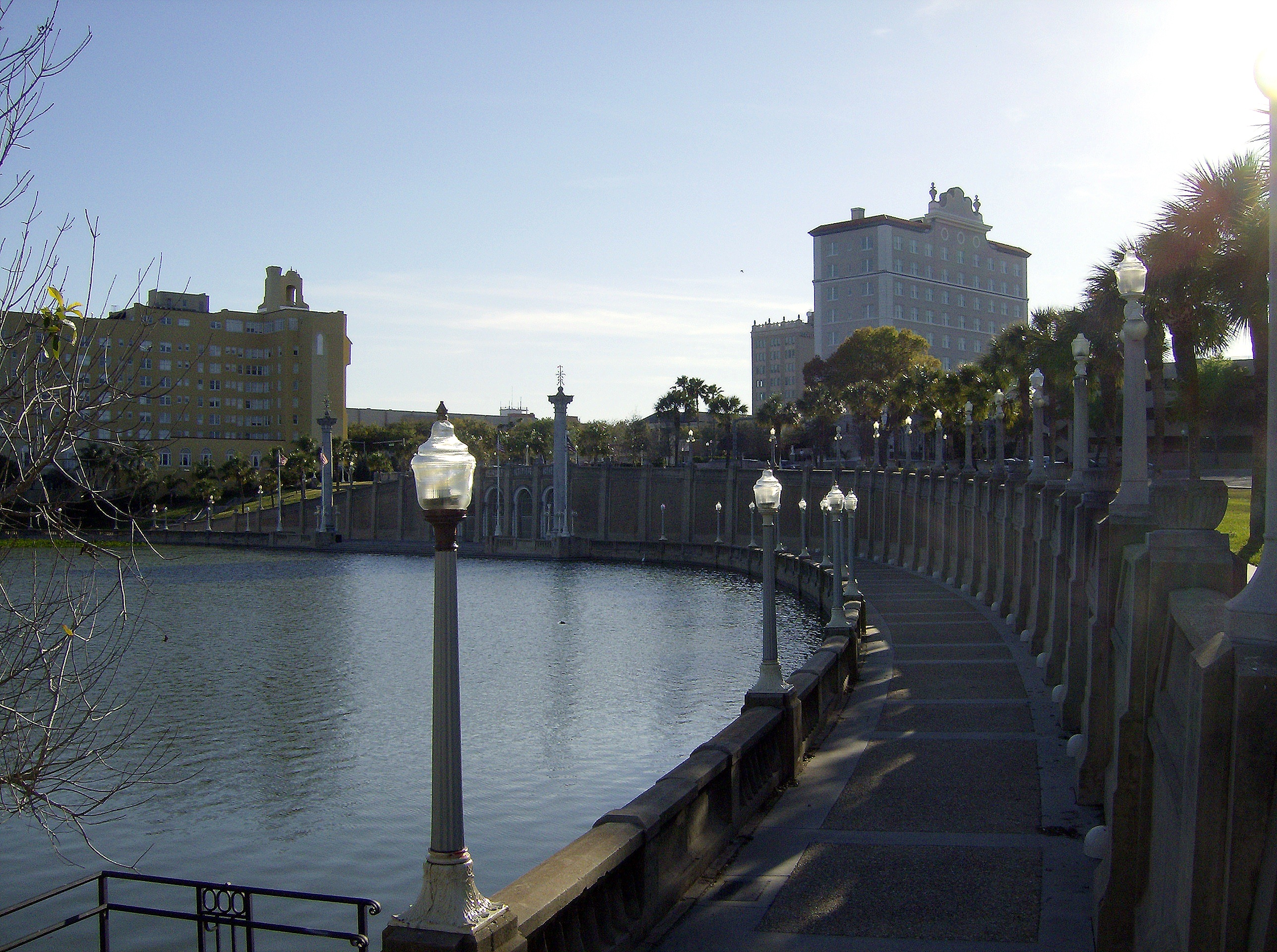|
Crystal Lake (Lakeland, Florida)
Crystal Lake is one of seven Crystal Lakes in Polk County, Florida, USA. It has a surface area of . This lake is inside Lakeland, Florida, and most of the area surrounding it is completely urbanized. It is bounded on the east by county road 659 and on the north by Crystal Lake Park and North Crystal Lake Drive. On the west it is bordered by homes. On the southwest it is bordered by South Crystal Lake Drive and on the southeast it is bounded by more homes. Crystal Lake has public access at Crystal Lake Park. This park has a fishing pier, a boat ramp and canoe access point, and some picnic tables. The park is open daily from dawn to dusk. There are no boat ramps or swimming areas along the lake shore, but it can be fished from the shore. The Take Me Fishing website says Lake Wire contains largemouth bass, bream and bluegill The bluegill (''Lepomis macrochirus''), sometimes referred to as "bream", "brim", "sunny", or "copper nose" as is common in Texas, is a species of North Am ... [...More Info...] [...Related Items...] OR: [Wikipedia] [Google] [Baidu] |
Lakeland, Florida
Lakeland is the most populous city in Polk County, Florida, part of the Tampa Bay Area, located along Interstate 4 east of Tampa. According to the 2020 U.S. Census Bureau release, the city had a population of 112,641. Lakeland is a principal city of the Lakeland–Winter Haven Metropolitan Statistical Area. European-American settlers arrived in Lakeland from Missouri, Kentucky, Tennessee, Georgia and South Carolina in the 1870s. The city expanded in the 1880s with the arrival of rail service, with the first freedmen railway workers settling here in 1883.Kimberly C. Moore, "Confederate vets, former slaves form Lakeland’s history" ''The Ledger'', 09 May 2018; accessed 27 June 2018 They and European immigrants also came ... [...More Info...] [...Related Items...] OR: [Wikipedia] [Google] [Baidu] |
Freshwater Lake
A lake is an area filled with water, localized in a basin, surrounded by land, and distinct from any river or other outlet that serves to feed or drain the lake. Lakes lie on land and are not part of the ocean, although, like the much larger oceans, they do form part of the Earth's water cycle. Lakes are distinct from lagoons, which are generally coastal parts of the ocean. Lakes are typically larger and deeper than ponds, which also lie on land, though there are no official or scientific definitions. Lakes can be contrasted with rivers or streams, which usually flow in a channel on land. Most lakes are fed and drained by rivers and streams. Natural lakes are generally found in mountainous areas, rift zones, and areas with ongoing glaciation. Other lakes are found in endorheic basins or along the courses of mature rivers, where a river channel has widened into a basin. Some parts of the world have many lakes formed by the chaotic drainage patterns left over from the last ice ... [...More Info...] [...Related Items...] OR: [Wikipedia] [Google] [Baidu] |
Polk County, Florida
Polk County is located in the central portion of the U.S. state of Florida. The county population was 725,046, as of the 2020 census. Its county seat is Bartow, and its largest city is Lakeland. Polk County comprises the Lakeland–Winter Haven Metropolitan Statistical Area. This MSA is the 81st-most populous metropolitan statistical area and the 89th-most populous primary statistical area of the United States as of July 1, 2012. The center of population of Florida is located in Polk County, near the city of Lake Wales. Polk County is home to one public university, one state college, and four private universities. History Early history The first people to inhabit the area now called Polk County were the Paleoindians who arrived in Florida at least 12,000 years ago, late in the last ice age. With large amounts of water locked up in continental ice caps, the sea level was more than lower than at present. The Florida peninsula was twice as wide as it is today, and Flor ... [...More Info...] [...Related Items...] OR: [Wikipedia] [Google] [Baidu] |
Largemouth Bass
The largemouth bass (''Micropterus salmoides'') is a carnivorous freshwater gamefish in the Centrarchidae ( sunfish) family, a species of black bass native to the eastern and central United States, southeastern Canada and northern Mexico, but widely introduced elsewhere. It is known by a variety of regional names, such as the widemouth bass, bigmouth bass, black bass, bucketmouth, largies, Potter's fish, Florida bass, Florida largemouth, green bass, bucketmouth bass, Green trout, gilsdorf bass, Oswego bass, LMB, and southern largemouth and northern largemouth. The largemouth bass is the state fish of Georgia and Mississippi, and the state freshwater fish of Florida and Alabama. Taxonomy The largemouth bass was first formally described as ''Labrus salmoides'' in 1802 by the French naturalist Bernard Germain de Lacépède with the type locality given as the Carolinas. Lacépède based his description on an illustration of a specimen collected by Louis Bosc near Charleston, S ... [...More Info...] [...Related Items...] OR: [Wikipedia] [Google] [Baidu] |
Bream
Bream ( ) are species of freshwater and marine fish belonging to a variety of genera including ''Abramis'' (e.g., ''A. brama'', the common bream), ''Acanthopagrus'', '' Argyrops'', ''Blicca'', '' Brama'', ''Chilotilapia'', '' Etelis'', ''Lepomis'', ''Gymnocranius'', '' Lethrinus'', ''Nemipterus'', ''Pharyngochromis'', ''Rhabdosargus'', ''Scolopsis'', or ''Serranochromis''. Although species from all of these genera are called "bream", the term does not imply a degree of relatedness between them. Fish termed "bream" tend to be narrow, deep-bodied species. The name is a derivation of the Middle English word ''breme'', of Old French origin. The term sea bream is sometimes used for gilt-head bream (''Sparus aurata''), (''orata'' in Italy, ''dorada'' in Spain) or porgies (both family Sparidae) or pomfrets (family Bramidae) . See also * Porgie fishing * Bluegill The bluegill (''Lepomis macrochirus''), sometimes referred to as "bream", "brim", "sunny", or "copper nose" as is c ... [...More Info...] [...Related Items...] OR: [Wikipedia] [Google] [Baidu] |
Bluegill
The bluegill (''Lepomis macrochirus''), sometimes referred to as "bream", "brim", "sunny", or "copper nose" as is common in Texas, is a species of North American freshwater fish, native to and commonly found in streams, rivers, lakes, ponds and wetlands east of the Rocky Mountains. It is the type species of the genus ''Lepomis'' (true sunfish), from the family Centrarchidae (sunfishes, crappies and black basses) in the order Perciformes (perch-like fish). Bluegills can grow up to long and about . While their color can vary from population to population, they typically have a very distinctive coloring, with deep blue and purple on the face and gill cover, dark olive-colored bands down the side, and a fiery orange to yellow belly. They are omnivorous and will consume anything they can fit in their mouth, but mostly feed on small aquatic insects and baitfishes. The fish are important prey for bass, other larger sunfish, northern pike and muskellunge, walleye, trout, herons, ... [...More Info...] [...Related Items...] OR: [Wikipedia] [Google] [Baidu] |
Lakes Of Polk County, Florida
A lake is an area filled with water, localized in a basin, surrounded by land, and distinct from any river or other outlet that serves to feed or drain the lake. Lakes lie on land and are not part of the ocean, although, like the much larger oceans, they do form part of the Earth's water cycle. Lakes are distinct from lagoons, which are generally coastal parts of the ocean. Lakes are typically larger and deeper than ponds, which also lie on land, though there are no official or scientific definitions. Lakes can be contrasted with rivers or streams, which usually flow in a channel on land. Most lakes are fed and drained by rivers and streams. Natural lakes are generally found in mountainous areas, rift zones, and areas with ongoing glaciation. Other lakes are found in endorheic basins or along the courses of mature rivers, where a river channel has widened into a basin. Some parts of the world have many lakes formed by the chaotic drainage patterns left over from the last ice ... [...More Info...] [...Related Items...] OR: [Wikipedia] [Google] [Baidu] |





_2020.jpg)